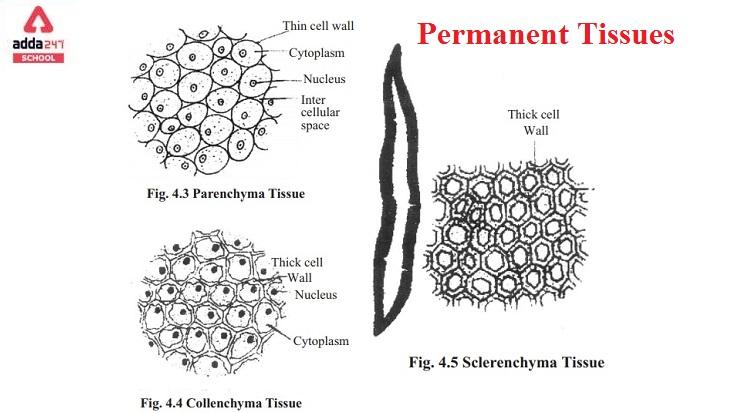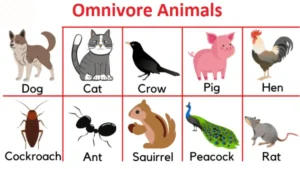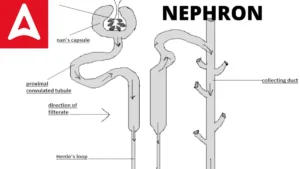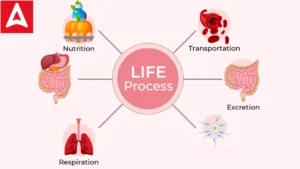Tissue is a biological organisational level in biology that exists between cells and an entire organ. Permanent tissues are tissues that have reached maturity, are fully grown, and have lost the ability to divide further.
Permanent Tissue
Tissues that are permanent are made up of cells that do not divide. These tissues’ cells have been changed to execute certain roles. Permanent tissue cells are completely matured, larger in size, and have a specific shape. The metabolic rate of cells in permanent tissues is lower.
Read About: Uses of concave lense
What is the types of Permanent tissue?
There are three types of permanent tissues, based on their structure, origin, and function, and are described below:
Simple permanent tissue
Simple permanent tissues are made up of cells with comparable structures and functions that come from the same source. They’re also known as homogeneous tissues. Simple permanent tissue exists in three different forms:
Parenchyma
Parenchyma is a type of basic permanent tissue that can be found all over a plant’s body. Living cells with thin cell walls that are loosely packed to allow for intracellular space make up these tissues. Parenchyma permanent tissue cells are typically round or oval in shape. Photosynthesis is carried out by parenchyma, which is made up of chlorophyll. It also includes storage capabilities as well as other features. It has cellulose-based cell walls, as well as vacuoles and a nucleus.
Collenchyma
Collenchyma is a living tissue made composed of cellulose, water, and pectin, and it has a thick cell wall. In these tissues, the cells are densely packed, resulting in a small amount of intracellular space. Due to the presence of pectin, it has the greatest refractive index. It has a lower chlorophyll content. It’s mostly found in the hypodermis of dicot leaves and stems, and it’s not found in monocot roots or monocot stems. It’s also found in the leaf edges to keep the leaf from being ripped apart by the wind. These tissues give the plant body mechanical strength, elasticity, and tensile strength. It also aids in the production of sugar within the plant’s body.
Sclerenchyma
Sclerenchyma tissue is made up of dead cells with a strong cell wall and a little amount of protoplasm. These tissues have a strong secondary cell wall that secretes lignin, which gives mechanical support to the plants. The intramolecular gap between the cells is completely absent. It is impervious to water because of its thick and strong lignin-based outer cell walls.
Complex Tissue
Complex permanent tissues are made up of a variety of physically distinct cells that work as a unit to accomplish a variety of complex functions. As a result, complex tissues are made up of cells of many types. Vascular tissues are complex permanent tissues that aid in the transfer of water, nutrients, and organic matter throughout the plant body. Xylem and Phloem are the two most prevalent complex permanent tissues found in plants.
Xylem
Wood tissue is termed to as xylem. Xylem tissues are crucial for transporting minerals and water from the plant’s roots to its leaves. It also gives the plants physical support. Parenchyma cells, fibres, vessels, and tracheid cells make up xylem tissues.
Phloem
Another form of vascular tissue found in plants is the phloem of the bust plant tissue. Its primary job is to transport food from leaves to other sections of the plant. A sieve tube, companion cell, phloem fibre, and phloem parenchyma make up phloem tissue. They are also responsible for transporting proteins and mRNAs throughout the plant body, in addition to food translocation.
Secretory Tissue
Secretory tissue refers to tissues that are involved in the secretion of gums, raisins, volatile compounds, honey, latex, and other similar substances. Plants have two types of secretory tissue.
Laticiferous Tissues
The latex in Laticiferous Tissues is a milky or yellowish pigment that is elongated, thick-walled, and multinucleated. Plants’ laticiferous tissues are dispersed throughout the mass of parenchyma cells.
Glandular Tissues
Glandular Tissues are glandular tissues. The secretory or excretory products are stored in these glands. Important oils, mucilage, gum, resin, tannin, digestive enzymes, and other essential substances are secreted by internal glandular tissues in numerous plants.
Difference between Meristematic tissue and Permanent tissue
Here, we will be discussing the difference between meristematic tissue and permanent tissue.
Basically, meristematic tissue gives rise to permanent tissues. The permanent tissues are formed when the meristematic tissues divide and differentiate. Meristematic tissues that specialise in a certain function do lose their ability to divide. Cellular differentiation is the process by which cells take on a permanent shape, size, and function. Meristematic tissue cells develop into many forms of permanent tissues.
Read About: Autotrophic Nutrition









 Omnivores Animals- Definition, Name List...
Omnivores Animals- Definition, Name List...
 Nephron: Definition, Diagram, Structure,...
Nephron: Definition, Diagram, Structure,...
 Life Processes: Check Nutrition, Transpo...
Life Processes: Check Nutrition, Transpo...









